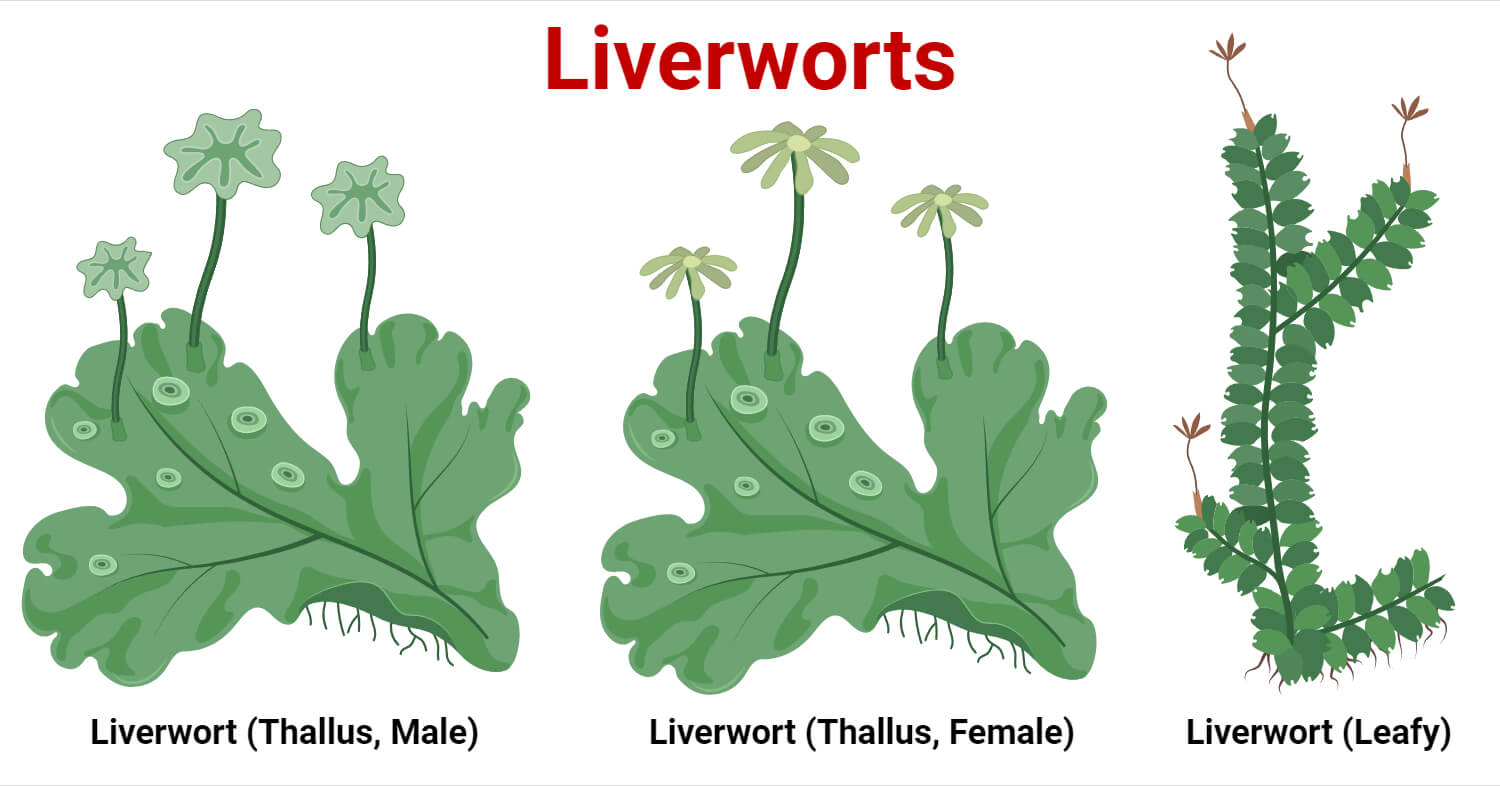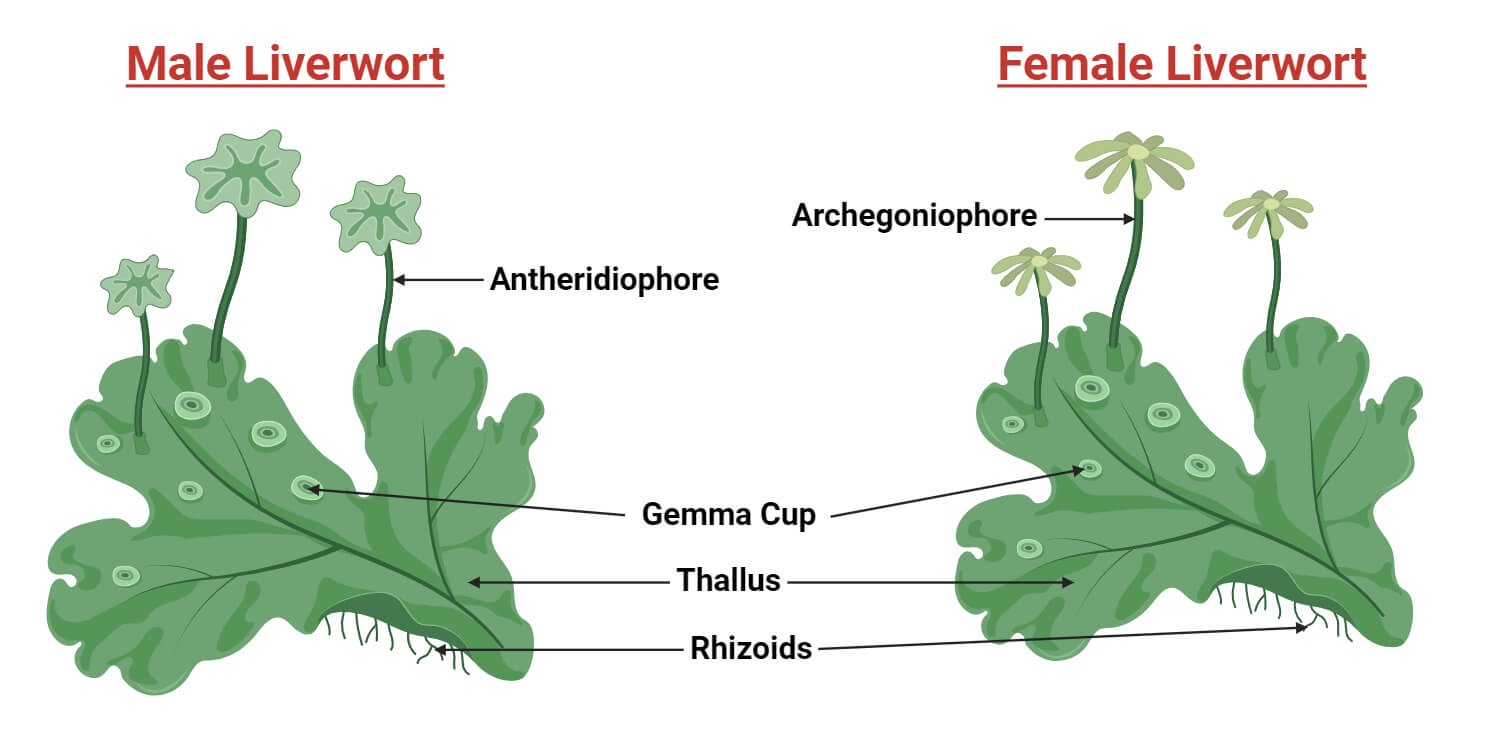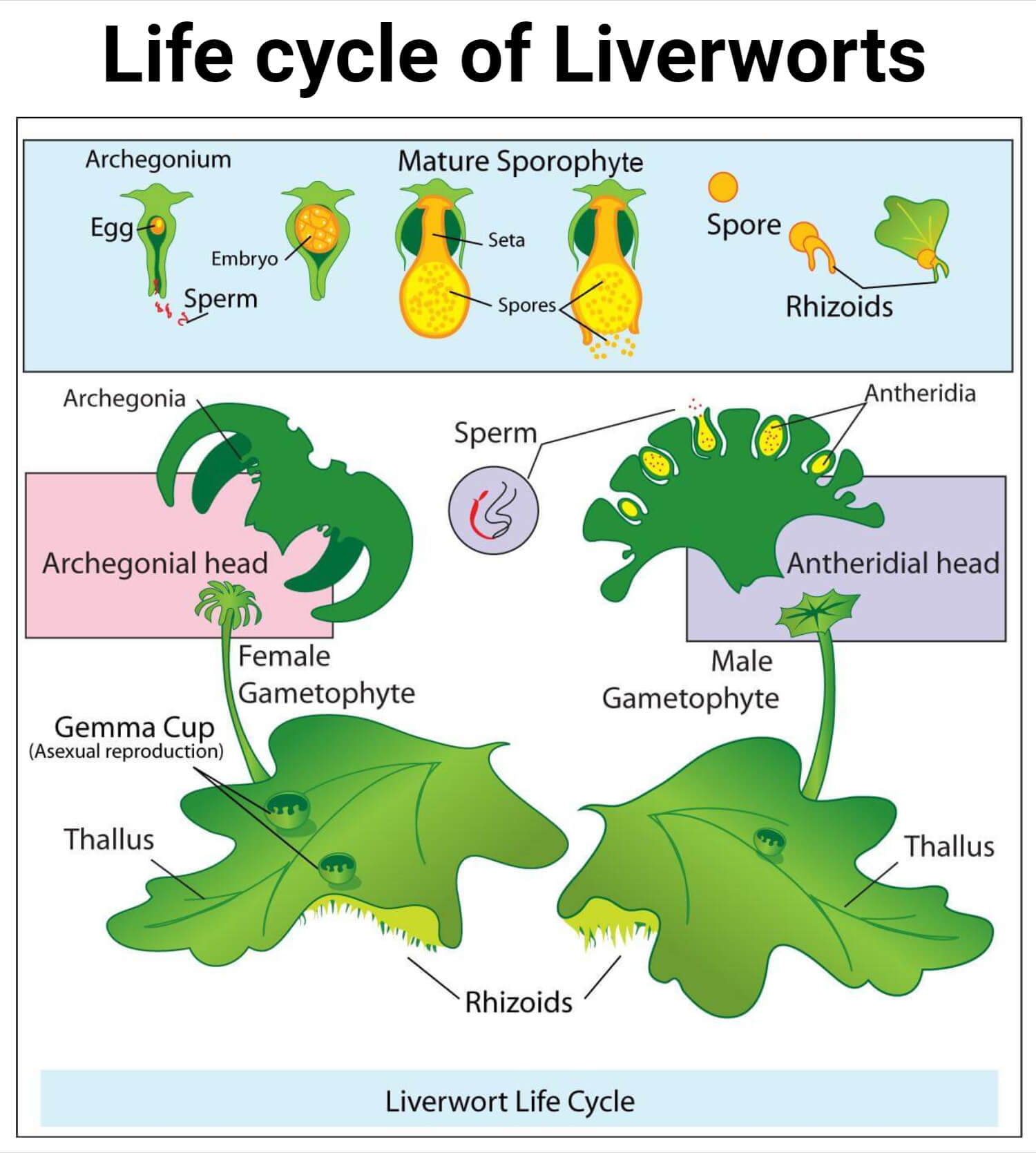The liverworts are bryophytes in which plant bodies are green, dorsiventral thallus that grows close to the ground which is attached to the substratum by delicate root like structure called rhizoids. The dominant plant in the liverworts is gametophyte with dichotomous branching.

Interesting Science Videos
Habitat of Liverworts
Liverworts do not grow in dry habitats as the plant body is not completely protected against desiccation. They prefer to grow in shady, humid areas where there is abundant moisture in the soil. They usually thrive in bank of streams, marshy ground, damp walls, rocks etc. However, there is an exception such as Riella are submerged and Riccia fluitans is aquatic.
Based on habitat, Liverworts may be:
- Terrestrial
- Aquatic
- Lithophytes
- Epiphytes
- Epiphyllous
Distribution of Liverworts
Liverworts are widely distributed but most of them are present in tropical region rather than in other parts of the world. Some of the species are cosmopolitan in their distribution. They extend their distribution from the Arctic, through the temperate zones to the tropical zones. They show active growth during May to September.

Morphology of Liverworts
The morphology varies from genus to genus. In some species, the plant body is flattened, ribbon like structure, dichotomously branched with scales and rhizoids at the lower surface. Some species like Marchantia also possess cup-like structures known as gemma cup and also specialized reproductive structures called antheridophore and archegoniophore.
In liverworts like Porella, the morphological structure is similar to mosses i.e. they possess small, overlapping leaves arranged in three rows along the stem. The leaves are usually one cell layer thick. They also possess rhizoids.
Anatomy of Liverworts
The anatomy of liverworts varies amongst the genus. In some species, there are distinct layers of cells performing different functions.
The common feature in anatomy of liverwort is presence of photosynthetic region and storage region. There are specialized cells called oil-bodies that stores oils and secondary metabolites and this is one of the unique features in liverworts.
Reproduction in Liverworts
Asexual Reproduction
They usually reproduce asexually by vegetative methods only. It takes place during the growing season. The most common methods of asexual reproduction are as follows:
- Fragmentation (A-C): The cells in the posterior portion of branched thalli die which eventually leads to disorganization and separation of young thallus lobes. This is known as fragmentation. Each fragment by apical growth and dichotomy gives rise to new genetically identical plant. The common examples of plants which propagate by this method are Riccia, Marchantia, and Pellia.
- Gemma formation (E-L): Gemmae are small bud like structures that are produced in large numbers. They are detached and carried by wind, water and eventually grows into new individuals in new habits. The common examples of plants that propagate through this method are Marchantia, Riccardia, and Lunularia. In Marchantia and Lunularia, gemmae are developed in small receptacles known as “gemma cups.”
- Adventitious branches (D): Adventitious branches arise from ventral surface of the thallus and become separated by death and decay of tissue connecting the branch with the parent plant. The detached adventitious branches grow into a new plant. Examples are- Riccia fluitans, Targionia etc.
- Tuber formation (N): In some liverworts, especially those exposed to desiccation, special subterranean branches are formed towards the end of the season. These branches eventually form tubers. Examples are- Cyathodium tuberosum, Petalophyllum, etc.
- Persistent apices: In certain species the growing apical portions of the thallus lobes with a certain amount of thallus tissue become thickened or otherwise modified. These thickened apices persist. These thickened apices persist and at the beginning of rainy season, the dormant apices resume growth resulting in a rosette of new plants. Examples are- Cyathodium, Athalamia etc.
- Regeneration: The liverworts possess an amazing power of regeneration. Isolated scales and rhizoids of Marchantiaceae could be grown into new plants under suitable conditions.

Sexual Reproduction
It is the usual method of reproduction in the bryophytes. The male and female sex organs in some species of liverworts are borne on different plants. The examples of this kind are Marchantia, Pellia etc. Such species are called dioecious. There are others in which both kind of sex organs are developed on the same plant. They are called monoecious. The sex organs are borne either at the anterior end or at the dorsal surface. They are either embedded on thallus like in case of Riccia or raised on special upright branches as in case of Marchantia and called the gametophores. Sexual reproduction takes place by the transfer of male gametes from antheridium to archegonium in the presence of water which leads to zygote formation.
Sporophyte: Zygote develops into sporophyte. In bryophytes, it is known as sporogonium. It remains attached to the gametophyte parent for its nutrition. In some species, sporogonium is differentiated into foot, seta and capsule. Capsule contains spore mother cell. Foot and seta are responsible for anchorage and absorbing purposes. However in some species like Riccia, foot and seta are absent.
Sporogenesis: It is the process by which diploid spore mother cell gives rise to haploid dispersal units known as the spores (meiospores). This process comprises of integrated series of events including meiosis. At the onset of sporogenesis, the spore mother cell increase in size and their wall gets thickened. The diploid nucleus of spore mother cell gets divided twice resulting into 4 haploid nuclei. The wall between four haploid nuclei laid simultaneously after the nuclear division dividing the spherical spore mother cell into four tetrahedral cells which later ripen into spores. The four spores remain together until they are fully grown which is known as spore tetrad. Sometimes, there are three distinct layers in the spore wall, the outer one is exosporium, the middle layer is called mesosporium and the inner one called endosporium. Spores lie freely inside the capsule and after reaching maturity, they dehiscence in different manners which may vary according to order of liverworts.
On germination, each spore produces alternate plant in the life cycle i.e. gametophyte. Thus meiospore is the initiation of gametophyte phase in liverworts.
Classification of Liverworts
Engler (1892) sub-divided the class Hepaticae (Hepaticopsida), into here orders-
- Marchantiales
- Anthocerotales
- Jungermanniales
Later many eminent biologists such as Campbell, Takhtajan, Smith and others suggested to elevate order Anthocerotales to the rank of class and ranked as different class.
In 1966, Schuster presented a scheme of classification of Hepaticae. He divided the class into 2 subclasses namely – Marchantiae and Jungermanniae.
Marchantiae: This includes 3 orders:
- Sphaerocarpels– The distinguishing fact about this order is: thallus without any internal tissue differentiation,and sex organs are surrounded by involucre.
- Monocleales– Thallus simple, involucres and numerous mucilage hairs present in sex organs, capsule cylindrical.
- Marchantiales– Thallus is flat, dichotomously branched internally differentiated into parenchyma region and air chambers.
Jungermanniae: This includes four orders:
- Takakiales– Thallus radially symmetrical, leaves isophyllus, spirally arranged, rhizoids absent rather rhizome like structure present.
- Calobryales– Thallus rhizomatous, leafy gametophytes erect bears simple leaves in three vertical rows, rhizoids absent.
- Jungermanniales– Thallus dorsiventral, but foliose, leaf without a midrib and without any tissue differentiation, capsule wall contains more than one cell in thickness.
- Metzgeriles– Thallus flat, dorsiventral, no any tissue differentiation, capsule wall more than one cell in thickness.
Crandall-Stotler, B., R.E. Stotler and D.G. Long (2008, 2009) constructed three divisions among bryophytes. They are;
- Marchantiophyta
- Anthocerotophyta
- Bryophyta
Under Marchantiophyta, they have proposed three classes:
- Haplomitriopsida
- Marchantiopsida
- Jungermanniopsida
Economic Importance of Liverworts
- Liverworts like Riccia and Marchantia are of medicinal importances. M.polymorpha is used to cure pulmonary tuberculosis and afflictions of the liver. Liverworts contain compounds with antibacterial, antifungal, and anti-inflammatory properties. These medicinal properties have been recognized in traditional herbal medicine and are currently being explored for potential pharmaceutical applications.
- Liverworts are highly sensitive to pollution and can modify their morphology, physiology, and anatomy if exposed to it, so they can be used as bio indicator. Species like Riccia gangetica, Riccia frostii are used as bio indicators.
- The liverworts have played an important role at research tools in various phases of botany such as genetics, morphology and physiology. Their simplest body structure makes it ideal for doing research. Liverworts like Marchantia polymorpha is a prominent model organism in plant biology and genetics.
- Liverworts play a critical role in soil formation by breaking down rocks and organic matter, which contributes to the creation of new soil. It also helps in preventing erosion and maintaining soil structure.
- Liverworts like Riccia and Marchantia plays an important role in ecological system by contributing in soil formation. Its ability to retain water in its tissue helps in retention of moisture in the soil.
- Liverworts can absorb heavy metals so they can be used in bioremediation.
References
- Bryophyte by Marchantia polymorpha is a prominent model organism in plant biology and genetics. B.R. Vashishta, A.K. Sinha, Adarsh Kumar (S.Chand & Company ltd)
- Biocyclopedia.com. (n.d.). Liverworts | Bryophytes: The liverworts, Hornworts, and mosses | Introduction to Botany | Botany | Biocyclopedia.com. https://biocyclopedia.com/index/introduction_to_botany/liverworts.php
- Crandal-stotler, B., R.e. Stotler and D.G.L. Long. (2008) 2009. Morphology and classification of the Marchantiophyta : 1-54, in B. Goffinet and A.J. Shaw (eds.) Bryophyte Biology 2nd Ed., Cambridge University Press, Cambridge.
- Schuster, R.M. 1966. The Hepaticae and Anthocerotae of North America. I. New York and London.
- Smith, G.M. 1955. Cryptogamic Botany. Vol. II. Bryophytes and Pteridophytes. Edi. 2, New York.
- Wilson, M. 1911. Spermatogenesis in Bryophyta. Ann. Bot., 25 : 415-459.
- Verdoorn, Fr. 1932. Classification of Hepatics. In Manual of Bryology, Chapter 15 : 413-422. The Hague.
- Stange, L. 1964. “Regeneration in Lower Plants”. In Advances in Morphogenesis V. IV, New York Academic Press. Pp. 111-153.
- Proskauer, J. M. 1962. Notes on Hepaticae. IV. The Bryologist, 65: 213–233.
- Proskauer, J. M. 1950. Notes on Hepaticae. I. The Bryologist, 53: 165–172.
- Proskauer, J. M. 1955. Notes on Hepaticae. III. The Bryologist, 58: 192–200.
- PROSKAUER J., 1962 ― On Takakia, especially its mucilage hairs. Journal of the Hattori botanical laboratory 25: 217-223.
